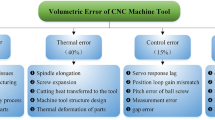Abstract
It is well known that the presence of cutter run-out has a significant effect upon the instantaneous uncut chip thickness through redistributing it and thereby contributes to the irregular change on the cutting forces in one tooth periods. In this paper, in order to avoid the numerical oscillations from differential model and to eliminate the influence of the ill-posed problem in calibration, a new approach to calibrate the cutter radial run-out parameters from the continuous cutting force model with constant cutting coefficients was proposed. Through analyzing the influence of the ill-posed problem in calibration of the tangential and radial cutting force coefficients, the corresponding solution method was proposed to enhance the calculation stability and to get a useful and stable solution. The cutting force coefficient matrix was optimized by incorporating the average cutting information in x and y directions based on the least square method. Furthermore, through numerical simulation and experimental results, the validity of the calibration approach is demonstrated.
Similar content being viewed by others
Reference
Koenigsberger F, Sabberwal AJP (1961) An investigation into the cutting force pulsations during milling operations. Int J Mach Tools Des Res 1(1):15–33
Kline WA, DeVor RE (1983) The effect of runout on cutting geometry and forces in end milling. Int J Mach Tools Des Res 23(2):123–140
Altintas Y (2000) Manufacturing automation, metal cutting, machine tool vibration and CNC design. CambridgeUniversity Press, Cambridge
Lazoglu I (2003) Sculpture surface machining: a generalized model of ball-end milling force system. Int J Mach Tools Manuf 43(5):453–462
Liang SY, Wang JJ (1994) Milling force convolution modeling for identification of cutter axis offset. Int J Mach Tools Manuf 34(8):1177–1190
Wang JJJ, Zheng CM (2003) Identification of cutter offset in end milling without a prior knowledge of cutting coefficients. Int J Mach Tools Manuf 43(7):687–697
Melkote SN, EndresbW J (1998) The importance of including size effect when modeling slot milling. J Manuf Sci Eng 120(1):68–75
Rivière-Lorphèvre E, Filippi E (2009) Mechanistic cutting force model parameters evaluation in milling taking cutter radial runout into account. Int J Adv Manuf Technol 45:8–15
Kao Y-C, Nguyen N-T, Chen M-S, Su S-T (2015) A prediction method of cutting force coefficients with helix angle of flat-end cutter and its application in a virtual three-axis milling simulation system. Int J Adv Manuf Technol 77:1793–1809
Wang B, Hao H, Wang M, Hou J, Feng Y (2013) Identification of instantaneous cutting force coefficients using surface error. Int J Adv Manuf Technol 68:701–709
Yun W-S, Cho D-W (2000) An improved method for the determination of 3D cutting force coefficients and runout parameters in End milling. Int J Adv Manuf Technol 16:851–858
Ko JH, Cho D-W (2005) Determination of cutting-condition-independent coefficients and runout parameters in ball-End milling. Int J Adv Manuf Technol 26:1211–1221
Lee T, Lin Y (2000) A 3D predictive cutting-force model for end milling of parts having sculptured surfaces. Int J Adv Manuf Technol l16(11):773–783
Wan M, Zhang WH (2006) Calculations of chip thickness and cutting forces in flexible end milling. Int J Adv Manuf Technol 29(7–8):637–647
Wan M, Zhang WH, Tan G, Qin GH (2007) New algorithm for calibration of instantaneous cutting-force coefficients and radial run-out parameters in flat end milling. Proc Inst Mech Eng B J Eng Manuf 221(6):1007–1019
Yang L, DeVor RE, Kapoor SG (2005) Analysis of force shape characteristics and detection of depth-of-cut variations in end milling. J Manuf Sci Eng 127(3):454–462
Author information
Authors and Affiliations
Corresponding author
Rights and permissions
About this article
Cite this article
Zhang, D., Mo, R., Chang, Z. et al. A study of computing accuracy of calibrating cutting force coefficients and run-out parameters in flat-end milling. Int J Adv Manuf Technol 84, 621–630 (2016). https://doi.org/10.1007/s00170-015-7707-9
Received:
Accepted:
Published:
Issue Date:
DOI: https://doi.org/10.1007/s00170-015-7707-9




